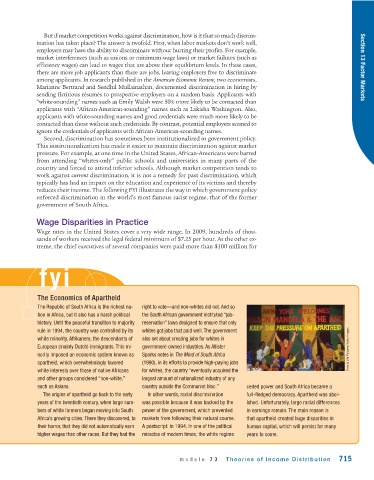Page 757 - Krugmans Economics for AP Text Book_Neat
P. 757
But if market competition works against discrimination, how is it that so much discrim-
ination has taken place? The answer is twofold. First, when labor markets don’t work well,
employers may have the ability to discriminate without hurting their profits. For example,
market interferences (such as unions or minimum-wage laws) or market failures (such as
efficiency wages) can lead to wages that are above their equilibrium levels. In these cases, Section 13 Factor Markets
there are more job applicants than there are jobs, leaving employers free to discriminate
among applicants. In research published in the American Economic Review, two economists,
Marianne Bertrand and Sendhil Mullainathan, documented discrimination in hiring by
sending fictitious résumés to prospective employers on a random basis. Applicants with
“white-sounding” names such as Emily Walsh were 50% more likely to be contacted than
applicants with “African-American-sounding” names such as Lakisha Washington. Also,
applicants with white-sounding names and good credentials were much more likely to be
contacted than those without such credentials. By contrast, potential employers seemed to
ignore the credentials of applicants with African-American-sounding names.
Second, discrimination has sometimes been institutionalized in government policy.
This institutionalization has made it easier to maintain discrimination against market
pressure. For example, at one time in the United States, African-Americans were barred
from attending “whites-only” public schools and universities in many parts of the
country and forced to attend inferior schools. Although market competition tends to
work against current discrimination, it is not a remedy for past discrimination, which
typically has had an impact on the education and experience of its victims and thereby
reduces their income. The following FYI illustrates the way in which government policy
enforced discrimination in the world’s most famous racist regime, that of the former
government of South Africa.
Wage Disparities in Practice
Wage rates in the United States cover a very wide range. In 2009, hundreds of thou-
sands of workers received the legal federal minimum of $7.25 per hour. At the other ex-
treme, the chief executives of several companies were paid more than $100 million for
fyi
The Economics of Apartheid
The Republic of South Africa is the richest na- right to vote—and non-whites did not. And so
tion in Africa, but it also has a harsh political the South African government instituted “job-
history. Until the peaceful transition to majority reservation” laws designed to ensure that only
rule in 1994, the country was controlled by its whites got jobs that paid well. The government
white minority, Afrikaners, the descendants of also set about creating jobs for whites in
European (mainly Dutch) immigrants. This mi- government-owned industries. As Allister Time & Life Pictures/Getty Images
nority imposed an economic system known as Sparks notes in The Mind of South Africa
apartheid, which overwhelmingly favored (1990), in its efforts to provide high-paying jobs
white interests over those of native Africans for whites, the country “eventually acquired the
and other groups considered “non-white,” largest amount of nationalized industry of any
such as Asians. country outside the Communist bloc.” ceded power and South Africa became a
The origins of apartheid go back to the early In other words, racial discrimination full-fledged democracy. Apartheid was abol-
years of the twentieth century, when large num- was possible because it was backed by the ished. Unfortunately, large racial differences
bers of white farmers began moving into South power of the government, which prevented in earnings remain. The main reason is
Africa’s growing cities. There they discovered, to markets from following their natural course. that apartheid created huge disparities in
their horror, that they did not automatically earn A postscript: in 1994, in one of the political human capital, which will persist for many
higher wages than other races. But they had the miracles of modern times, the white regime years to come.
module 73 Theories of Income Distribution 715

